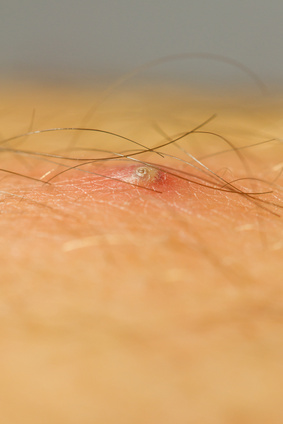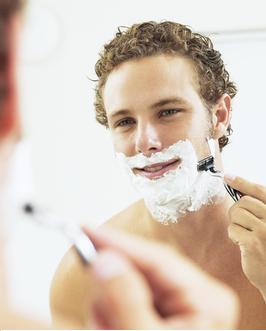- Home
- Ingrown Hair
Treating Ingrown Hair
Visit this
PICTURES OF RASHES PAGE
Ingrown hair is generally not a serious skin care problem, but it can be unsightly, painful and very bothersome for men and even for women. This skin condition can also be known as razor bumps or in medical terms pseudofolliculitis barbae. Hairs that are ingrown are more common among individuals with curly hair, especially African American men.
Symptoms of Hair that is Ingrown
An ingrown hair problem is generally characterized by a number of symptoms, but each person may experience the symptoms slightly differently. The most common symptom of ingrown hairs is inflammation of the skin in localized small bumps. The degree of inflammation will vary.

Within the center of the bump, a barely visible curled hair is present. Accompanying the swelling is redness, mild pain, and itchiness. Ingrown hair can also lead to the formation of puss in the affected areas.
As will be discussed later, hairs that become ingrown are closely associated with the act of shaving.
Therefore, the beard and neck areas in men are prime locations for ingrown hair to occur and it can be a significant mens skin care problem. However, women also commonly shave certain body areas and therefore, like men, women are also concerned about ingrown-hair. For women, the legs, underarms, and bikini area are all usually affected by these razor bumps.
Ingrown hair symptoms may resemble other skin care problems. One such problem is known as keratosis pilaris. This is a non-contagious skin condition that produces symptoms similar to ingrown hairs and it is commonly found on the upper arms, thighs, and occasionally on other body areas. Old shedding skin cells that get trapped in hair follicles cause this condition.
What Causes Ingrown Hair to Occur?
When a hair shaft is cut it has a sharpened edge and as this hair strand grows, it might curl back into the same hair follicle and get trapped underneath the skin surface. Basically, it grows back into the skin. Also, new hairs may also get caught under the skin surface without ever being cut. These scenarios create the irritation symptoms that occur with ingrown-hair.
Information on ingrown pubic hairs can be found at this page.
Treatments and Prevention
Often the hairs disappear on their own by growing out from beneath the skin’s surface. In addition, ingrown hairs can be removed by carefully lifting them out of the skin with tweezers. The hairs should not be plucked.
However, for many individuals this is a chronic skin problem that does require more sophisticated action to be taken to alleviate the discomfort.
Possible treatments for individuals with chronic ingrown-hair problems are the use of depilatory creams or electrolysis in order to remove the hair. No hair, no ingrown-hair problem! Depilatory creams are used for the short-term removal of the hair. For a more permanent hair removal method, then electrolysis is the way to go. A dermatologist, depending on the severity of the condition, can prescribe other treatments. Topical antiseptics may be used to prevent infections from occurring or when there is infection, antibiotics may be required.
Although it is not always possible to stop hair from becoming ingrown, the best treatment is prevention.

Shaving Tips for Preventing Ingrown Hairs or Razor Bumps
Shaving often causes an ingrown hair problem to occur and that is why it is also referred to as razor bumps. Therefore, the best prevention technique is not to shave. Although this is a very logical approach, it is not very practical because not all men want facial hair and not all women are thrilled to have hairy legs or armpits. The alternative is to practice proper shaving techniques consistently and to follow certain shaving tips as described below.
Shave with an Electric Razor
Many individuals have found that shaving with an electric razor reduces the occurrence of hairs that are ingrown or razor bumps. This is likely due to the fact that electric razors do not shave as close as a wet blade. With blades, the shave is much closer and there is a greater chance of the cut and sharpened end of the hair to re-enter the hair follicle.
Use Shave Gel Instead of Foam
Gels are typically less irritating whereas foams can dry-out and irritate the skin. The shave gel product should contain plenty of lubricating agents and be specially formulated for sensitive skin. Do not use any product that contains alcohol. Alcohol will make this skin care problem substantially worse because it will dry out the skin and close the pores.
Wash the Skin Before Shaving
Wet hair is full of moisture and cuts easier. On the other hand dry hair is tougher and stronger. As a razor encounters this tougher hair, it gets pulled up from the follicle and then retracts beneath the skin surface after it is cut. This increases the risk of ingrown-hairs because the cut hair gets trapped inside the hair follicle and digs inward or sideways into the skin as it grows. The hair to be shaved should be wet for around five minutes prior to shaving. Washing the skin before shaving also helps to exfoliate it and helps lift the hairs away from the skin follicle.
Shave in the Direction of Hair Growth and this Same Direction Each Time
For men, the direction of shaving is downwards on the cheeks, chin, and moustache areas and upwards on the neck. For women this means shaving downwards on the legs. This is a very important factor in preventing hairs from becoming ingrown. It prevents the hair from being cut too short. If shaving with the hair grain (direction of growth) is done consistently, then the hair can be trained to grow out straight, which prevents it from curling back into the skin.
Shaving against the grain will give a closer shave and some individuals prefer this technique. However, if one is prone to skin irritation and the development of hairs becoming ingrown then shaving with the grain of the hair is strongly recommended.
Shave with Skin in a Relaxed State
When shaving it is best not to pull the skin too tight. A little pressure is okay, but too much stretching will result in the hair being cut too short. Also, do not use too much pressure on the blade.
Avoid Repeated Strokes in the Same Area
Repeated strokes with the razor over the same area will cause the hair to be cut too short and result in a greater chance of the development of this problem. Also, a single blade razor is generally preferred. With rigid twin blade razors, the first blade lifts the hair and the second blade cuts it deep and usually at an angle that makes the development of ingrown hair likely. Pivoting head razors with multiple blades are not as bad as the fixed blades razors.
Other Tips for Preventing Hair from Becoming Ingrown
Exfoliate the Skin
Exfoliating the skin can be a very useful procedure for preventing hairs that are ingrown or razor bumps. This process will remove the barriers that prevent the hair from growing out of the skin. It should be performed regularly when bathing or when the face is washed. Exfoliation can be performed with a gentle scrubbing pad, an exfoliating glove or a loofah. Certain creams that contain beta hydroxy acids, such as salicylic acid can help to exfoliate the skin and are very effective in reducing razor bumps.
Practice Daily Health Skin Care
Daily moisturization of the skin is necessary as well to prevent ingrown hair. Gentle cleansing and proper moisturization will keep the skin smooth and supple and will keep the hair follicles moisturized and the hair growing in the right direction. The moisturizer used should not clog the pores – such products are labelled as noncomedogenic.
face skin care | mens skin care | ingrown hair
